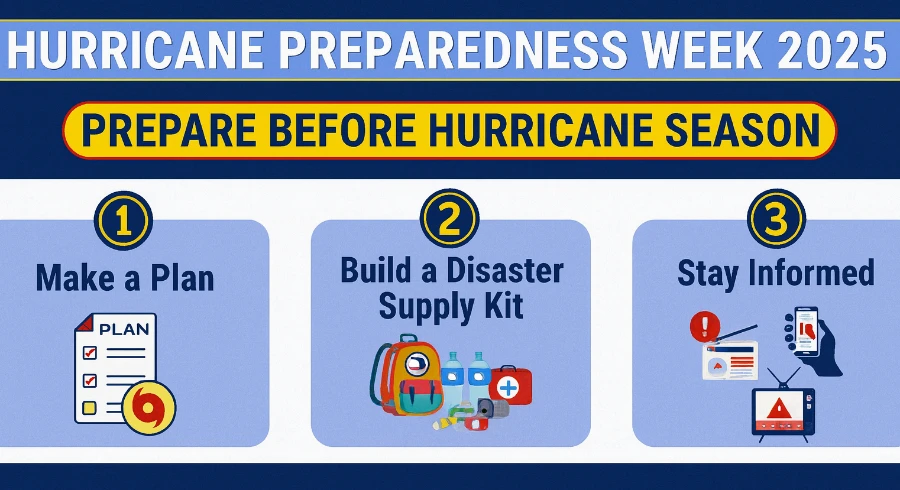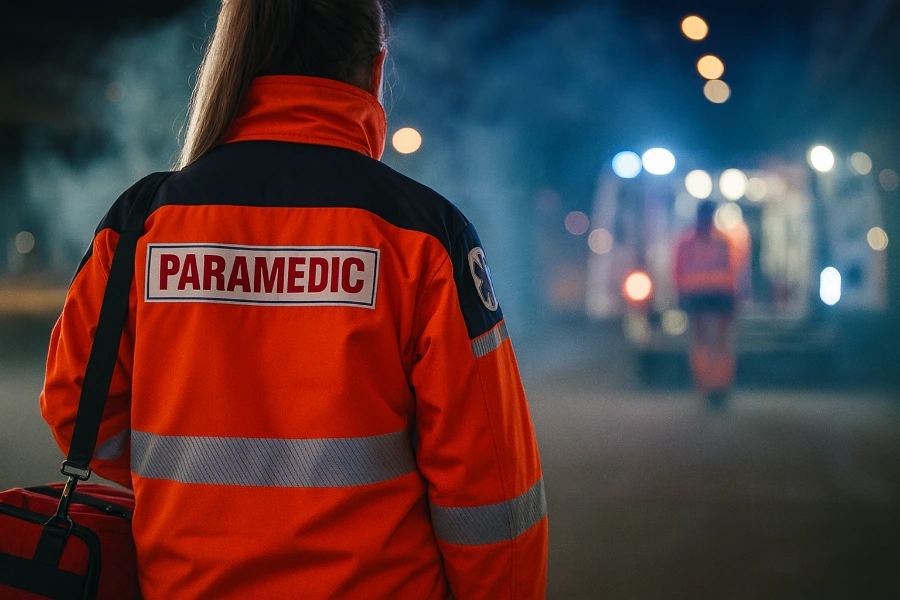Key Takeaways
• EMS readiness during the late-season remains essential, as storms can form well into November.
• Coordinated planning, family preparedness, and community engagement strengthen response and recovery.
• Small practical steps—renewing supplies, digitizing documents, confirming routes—make a big difference in emergencies.
Why Late-Season Hurricanes Are Especially Dangerous
The Overlooked Threat After September
Many Florida residents mistakenly assume hurricane risks taper off after September, leading to reduced preparedness. Storms like Hurricane Wilma and Milton made landfall in late October and caused widespread damage. Atmospheric conditions in October and November often remain favorable for tropical development. Warmer-than-average sea surface temperatures continue to feed storm systems. Public awareness campaigns rarely focus on late-season threats, making these storms more dangerous.
Peak Season vs. Final Stretch: Key Differences
Late-season hurricanes frequently form in the western Caribbean and Gulf of Mexico, where water temperatures remain warm. These storms often move faster and are harder to predict due to shifting weather patterns. Cooler fronts pushing southward can interact with tropical systems, intensifying wind fields. Rainfall tends to become more localized but severe, causing flash flooding in vulnerable inland areas. Emergency planners must adapt quickly to these evolving dynamics, especially in coastal and low-lying regions.
This table compares average storm formation by month, highlighting how October and November still contribute significantly to seasonal risk. It reinforces why EMS readiness must extend through the official season end.
| Month | Avg Named Storms | Avg Hurricanes | Percentage of Annual Named Storms |
|---|---|---|---|
| August–October (peak) | 11–12 | — | ≈ 80–90 % |
| October | ~2.0 | — | ~15 % |
| November | ~0.5 | — | ~3–4 % |
EMS Systems Under Pressure: What Late-Season Readiness Requires
Maintaining Operational Continuity Past Peak Season
Emergency medical response teams often operate under strain as the season extends due to cumulative deployments. Crews experience burnout after responding to earlier disasters. Rotating personnel becomes essential to avoid fatigue-related mistakes. Equipment requires more frequent checks due to prolonged deployment cycles. Supply chains also stretch thin, especially for medical gear and fuel. Agencies must anticipate delays and establish contingency contracts to ensure operational continuity.
Challenges in Staffing, Staging, and Deployment
Staffing poses unique problems in October and November when seasonal workers exit and school calendars limit availability. Staging decisions must account for changing storm tracks and potential road closures. Agencies often reposition ambulances and triage units closer to high-risk zones. Limited daylight hours and cooling temperatures complicate setup and recovery efforts. Previous storms like Hurricane Michael offer valuable case studies in managing these late-season complexities.
Coordinated Response Planning for the Final 60 Days
Cross-Agency Communication Protocols
Effective disaster response hinges on seamless coordination across EMS, fire, police, and emergency management agencies. Dispatch centers must implement flexible call-routing to avoid overloads. Standardized radio frequencies allow for real-time updates during staging and evacuation. Pre-event coordination meetings ensure alignment on terminology and task assignments. Mobile command units help streamline decision-making in fluid environments. These strategies significantly reduce confusion during peak storm activity.
Facility Readiness and Shelter Coordination
EMS teams often support temporary shelters where medical needs escalate rapidly. Coordinators must pre-screen facilities for accessibility, power stability, and clean water. Clear triage protocols simplify intake during high-volume scenarios. Emergency shelters must accommodate oxygen-dependent patients and those with mobility impairments. EMS units can serve as on-site rapid response hubs when transportation is compromised. Partnerships with local hospitals help manage overflow and redirect non-critical cases, allowing healthcare professionals to focus on complex cases without service disruption.
Personal Preparedness for EMS Professionals
Protecting Your Own Family During Deployment
First responders often leave families behind during emergencies. Agencies should encourage staff to create personal preparedness plans. These plans include designated contacts, evacuation routes, and secondary housing options. Go-bags for children and pets ensure smooth transitions if relocation becomes necessary. Trusted neighbors or family members can provide support in the responder’s absence. Maintaining peace of mind at home allows personnel to focus more effectively on their duties.

Mental and Emotional Strain Management
Extended hurricane seasons take a toll on mental health. Exposure to trauma, coupled with sleep deprivation, amplifies stress levels. EMS professionals should access counseling or peer support programs early. Shift leaders must check in regularly to monitor staff well-being. Encouraging open dialogue helps reduce stigma around mental health care. EMS teams trained in emergency pediatric care often face heightened emotional strain, making ongoing PALS renewal a critical part of readiness.
Smart Community Engagement in the Off-Peak Months
Educating the Public Beyond September
Public education often fades after the September peak, even though risk remains high. Agencies can host October community forums to highlight ongoing threats. Interactive sessions with EMS crews build trust and clarify emergency protocols. Social media campaigns should emphasize late-season storm behavior. Schools offer a channel for educating children and their families. Reinforcing these messages ensures communities remain alert through November.
Neighborhood Resilience and Mutual Aid
Strong neighborhoods support faster EMS response times. Residents should identify vulnerable individuals and create block-level check-in systems. Community Emergency Response Teams (CERT) extend the reach of professional responders. Shared storage of basic supplies ensures no one is left without essentials. EMS can offer workshops on using radios or first-aid kits effectively. These grassroots efforts enhance overall resilience.
3 Practical Tips for Immediate Late-Season Readiness
Rotate & Refresh Supplies Now
Emergency kits often degrade by the end of hurricane season. Inspect food, batteries, and medication expiration dates regularly. Replace any items that show wear or have been used. Keep flashlights, weather radios, and power banks fully charged. Maintain a log to track rotations and restocking. A fresh kit boosts confidence when a late-season storm approaches.
Digitize Critical Documents
Store digital copies of identification, insurance, and medical records on encrypted USB drives or cloud services. Physical copies should go in waterproof folders within your go-bag. Smartphones can scan documents using built-in apps. Ensure all household members know where to find these backups. Fast access to documents expedites claims and medical services post-storm.
Reconfirm Evacuation and Reentry Routes
Evacuation routes may change due to roadwork or flooding. Revisit local maps and emergency instructions at least monthly. Use GPS apps with offline capabilities in case of signal loss. Coordinate reentry plans with all family members, especially children or elderly relatives. Bookmark official local emergency management websites for real-time updates. Quick navigation reduces risk during high-stress situations.
Tactical Recovery: EMS Roles After the Storm Passes
Mold, Floodwater, and Medical Emergencies
Post-storm environments pose new health threats, especially mold and bacterial exposure. Mold can begin forming within 24 hours of flooding. EMS teams must wear proper protective gear during patient contacts. Floodwater injuries and gastrointestinal illnesses spike after hurricanes. Deploying mobile EMS units improves care access when clinics remain closed. Early triage reduces ER burden and improves recovery outcomes.
Damage Documentation and System Reporting
Accurate post-event documentation informs both insurance and internal process improvements. EMS responders should photograph damage before initiating repairs. Logs should include date, time, and GPS coordinates for each incident. Agencies must gather data on delayed response zones for future planning. After-action reports support budget justifications and training revisions. Transparent reporting enhances public trust and agency readiness.
FAQ: EMS & Late-Season Hurricane Response
What are the biggest operational challenges for EMS after October?
Staff fatigue and resource scarcity emerge as the top hurdles. Agencies must stretch personnel and inventory into November without compromising care.
How can families of EMS workers best prepare during hurricane season?
Creating a separate family plan ensures safety while responders deploy. Clear communication channels and emergency contacts prevent confusion.
Are EMS teams required to stay active through the full hurricane season?
Yes. The official season ends November 30, and agencies must maintain full readiness until that date.
How do EMS agencies decide when to stage units before a late-season storm?
They monitor forecasts closely and use historical patterns to determine optimal staging locations. Risk zones often shift quickly late in the year.
Avoiding Complacency in the Final Weeks
How Agencies Can Maintain a Readiness Mindset
Leadership plays a critical role in sustaining operational focus. Regular scenario-based training helps staff stay mentally prepared. Agencies should rotate responsibilities to prevent burnout. Updated checklists and equipment audits keep teams sharp. Joint drills with hospitals and fire departments reinforce collaboration. These practices prevent dangerous lapses during the final storm threats.
Messaging That Reinforces Awareness
Messaging must emphasize the active risk period through November. Weekly updates, including weather alerts and safety tips, keep the public informed. Avoid statements that imply the worst is over. Use clear, direct language in all communications. Share real stories from past late-season events to drive urgency. Well-timed messaging preserves both public and responder readiness.
Looking Ahead: Building Smarter EMS Protocols for 2026
Policy Reforms for Year-Round Disaster Readiness
Agencies must advocate for funding beyond the traditional peak months. Legislators need to understand the toll extended seasons take on EMS systems. Budgeting should include year-round reserves for fuel, PPE, and overtime pay. Technology upgrades such as mobile dashboards improve coordination. Sustained investment in readiness builds safer communities across seasons.
Lessons from This Season to Integrate Now
Field reports from late-season deployments reveal what worked and what failed. Agencies should compile lessons while events remain fresh. Crew feedback should influence next year’s protocols and training modules. Advancements in predictive modeling may improve staging and evacuation efficiency. A proactive approach transforms short-term experiences into long-term resilience.
Jeromy VanderMeulen is a seasoned fire service leader with over two decades of experience in emergency response, training, and public safety management. He currently serves as Battalion Chief at the Lehigh Acres Fire Control & Rescue District and is CEO of the Ricky Rescue Training Academy, a premier provider of online and blended EMT and firefighter certification programs in Florida.
Jeromy holds multiple degrees from Edison State College and the Community College of the Air Force, and is pursuing his MBA at Barry University. He maintains top-tier certifications, including Fire Officer IV, Fire Instructor III, and Fire Inspector II, and has served as a subject matter expert for a court case. He is a member or the Florida Fire Chiefs Association.
Jeromy also contributes to state-level fire safety regulation and serves on several hiring and promotional boards.

